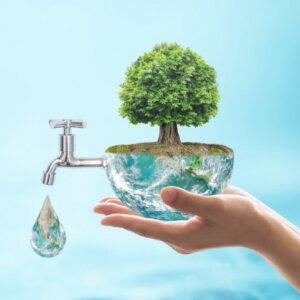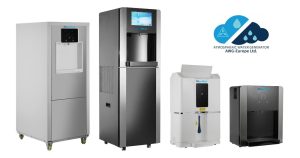This article is for those who understand the importance of the problem and are willing to take action to save water
There are huge differences in the water consumption and usage habits of the Earth’s inhabitants. At one extreme is excessive waste, at the other is the fact that two billion of our fellow human beings simply do not have access to safe drinking water. Apart from these extremes, and excluding agricultural and industrial use, it is of course the “average” citizens who account for the majority of global water consumption.

Water footprint
The water footprint shows how much water we use as consumers, both directly and indirectly, through our consumer goods. Of course, we don’t just consume water when we drink, wash our hands, cook, or clean, but also when we use services and purchase products that require water.
Not only people and countries, but also individual industries have a characteristic water footprint. Overall, for example, agriculture accounts for 70% of the country’s total water consumption, while industry accounts for 20%. Only the remaining 10% is used directly by households from their taps.
If you are interested in calculating your own water footprint, you can do so with this calculator: Personal water footprint calculator by Water Footprint Network
What do we need water for and how much?
For example In Hungary, we consume an average of 110 liters of water per person per day (e.g., for food, hygiene, cleaning, and irrigation). However, our total water footprint averages more than 2,000 liters per day when indirect use is also taken into account. Below are some examples of the amount of water required to produce certain products:
- 200 liters for a glass of milk (about a full bathtub)
- 40 liters for a slice of bread (4 full toilet tanks)
- 2,000 liters for the production of one cotton T-shirt (10 full bathtubs)
- 2,400 liters for the ingredients and preparation of one hamburger (12 full bathtubs)
Attitude towards water conservation
Those who revel in their prosperity – even if they live in areas with water shortages – are unlikely to be interested in the issue and will continue to insist on their swimming pools and their daily water consumption of more thousands of liters per person. Those less fortunate, who have no access to drinking water or only have limited access to it, obviously do not need to be lectured on not wasting water.
And then there are us, average Europeans, hopefully sensible people, who are increasingly faced with water supply problems and poor-quality tap water, and who carry around PET bottles of water to overcome the daily water needs.
Why should we conserve water?
The planet’s freshwater reserves are dwindling, surface and groundwater sources are drying up and becoming significantly polluted. However, the global climate crisis and the water shortages affecting many countries and regions of the European Union have led many of us to wonder how long the current water supply system will be sustainable and what we can do to protect the environment, including water resources.
Most of us enjoy piped water supplies, but as sources dry up and more and more public utilities fall into the hands of private companies, prices are rising rapidly and steadily.
In light of global environmental goals, it may be “just a drop in the ocean” if a single household reduces its consumption, but if this happens on a large scale, it will have a significant impact! In addition to lofty goals, it is of course worth saving on household water and sewer bills!

How can we save water?
It is important to not only pay attention to your direct water consumption at home, but also to consume everything else in moderation, consciously and wisely. Here are some practical tips for saving water at home:
Bathroom
- Take short showers: Don’t let the water run while soaping up or washing your hair. The shower can consume a lot of water in a matter of seconds.
- Collect water: While waiting for the hot water to run, collect the running water in a basin or bucket, which you can later use to water plants or flush the toilet.
- Brush your teeth and wash your hands: Don’t let the water run while brushing your teeth or washing your hands.
Kitchen
- Use a dishwasher: If you have a dishwasher, use it; if not, wash dishes in standing water rather than under running water. If you pay attention to the order in which you wash the dishes, you can wash them with less water.
- Drink tap water: If possible, drink tap water instead of bottled water.
- Don’t defrost food in cold water: Use the water needed to defrost food for other purposes (e.g., watering plants).
Yard and garden
- Collect rainwater: Use a rainwater collector to water your plants.
- Water consciously: Water early in the morning or in the evening so that less water evaporates.
Other
- Reuse water: You can use water that has already been used but is still clean, such as rainwater, for watering.
- Choose energy-efficient appliances: If possible, replace older, outdated appliances with energy-efficient models.
- Choose shorter cycles: If you have a washing machine, use shorter cycles and wash at lower temperatures if possible.
An inexhaustible source: water from the air

Today, about 3/4 of the earth’s population has access to healthy drinking water from dwindling surface or subsurface sources. However, nearly 2 billion people (80 countries) already lack access to healthy, clean drinking water.
Few people think about it, but 12-16,000 km3 of fresh water is stored in the form of moisture in the Earth’s atmosphere – equivalent to the water volume of the Great Lakes in North America, the largest natural freshwater reservoir on our planet.
The atmospheric water generator could be one of the most encouraging innovations in solving the global drinking water problem!
One cubic meter of air (depending on humidity) consists of an average of 4-25 grams of water vapor. In theory, current AWG technologies can condense approximately 20-30% of atmospheric moisture into drinking water.
Solving the water problem individually
AWG-Europe sells atmospheric water generators, which can be a good solution for temporary or permanent water shortages. This equipment utilizes atmospheric moisture and provides healthy, clean drinking water for family, office, community, or industrial use.
Are you open to innovation and want to be independent of drinking water suppliers? …If so, choose the WizzWell atmospheric water generator that best suits your needs!


Good post! We will be linking to this particularly great post on our site. Keep up the great writing
I’ve bookmarked this. Also check out https://pdfpanel.com for PDF editing.
This helped me rethink my strategy. Thanks for the inspiration!
Insightful post — I’d be interested in a follow-up on advanced topics.
Thanks for the breakdown — the comparisons were particularly useful.
I love the practical tips in this post. Can you recommend further reading?
I appreciate you sharing this blog post. Thanks Again. Cool.
Good post! We will be linking to this particularly great post on our site. Keep up the great writing
I appreciate the balanced view — you didn’t oversell the solution.
Informative and well-referenced. Do you have a resource list?
Pretty! This has been a really wonderful post. Many thanks for providing these details.
Pretty! This has been a really wonderful post. Many thanks for providing these details.
Fantastic site A lot of helpful info here Im sending it to some buddies ans additionally sharing in delicious And naturally thanks on your sweat